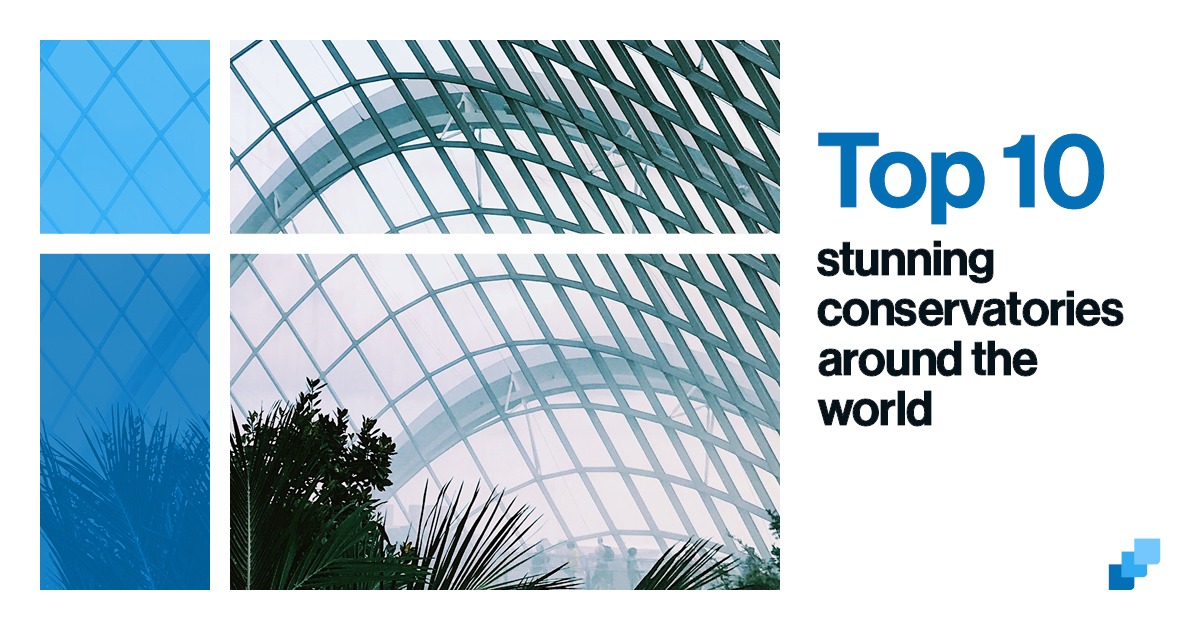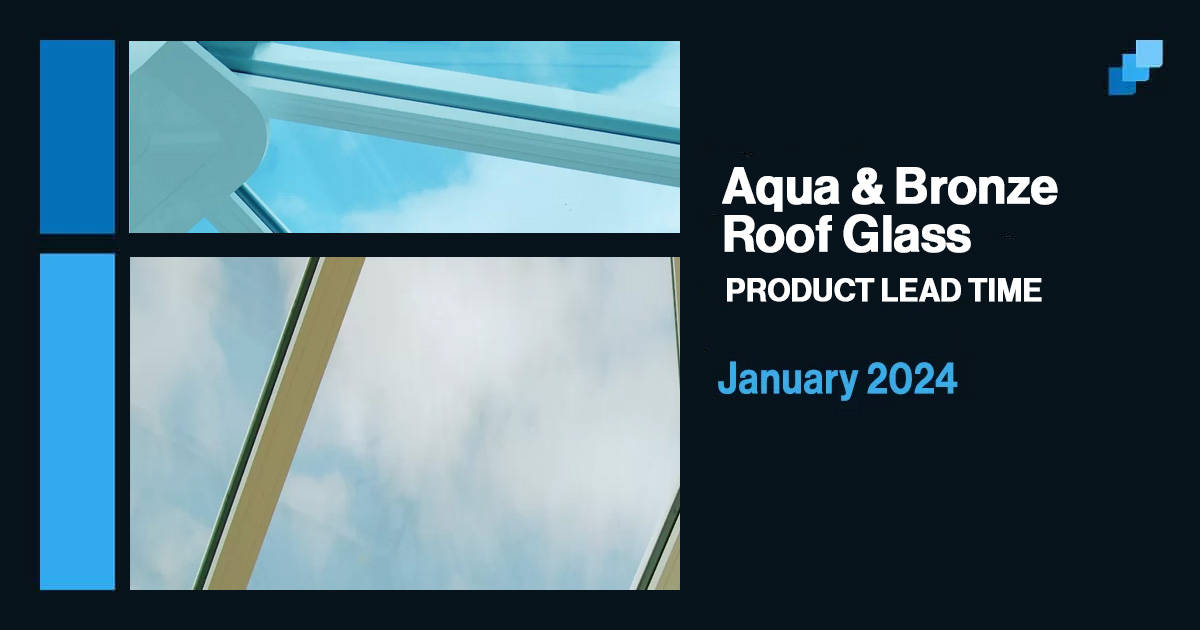We love a top 10 here at Clayton Glass. Therefore, this week we’ll be delving into the top 10 truly stunning conservatories, that exist in various locations all over the world. Some you may have heard of. Some you won’t believe you weren’t aware of. A few will literally make you want to get straight on a plane and see the real thing for yourself. So, here are the top 10 stunning conservatories, in the world, in order, here we go. First up at 10…
PLEASE NOTE: ALL CHOICES ARE THE OPINION OF THIS WRITER
#10: THE PALM HOUSE OF BELFAST BOTANIC GARDENS (NORTHERN IRELAND)

Location: Belfast, GBR
Opened: 1840
Designer(s): Charles Lanyon, Richard Turner
First up, we have the Belfast Palm House, located in the magnificent botanical gardens of Northern Ireland’s capital city. The 28-acre botanic gardens of southern Belfast are popular with tourists and locals alike, because of their radiant beauty, and diverse array of plant life.
The gardens themselves opened to the public all the way back in 1828, with construction of the beautiful Palm House reaching completion 12 years later. The Palm House consists of two wings, firstly a tropical wing – earning the conservatory its name, and also a cool wing for plants more local to the region.
Designers Charles Lanyon & Richard Turner designed the tropical wing to be taller. So as to accommodate some of the massive plants that would go on to reside in the stunning conservatory.
INTERESTING FACT: Belfast Palm House’s tropical wing currently contains an 11-metre tall Australian Globe Spear Lily, which finally bloomed in 2005 after a 23-year wait!
#9: ENID A. HAUPT CONSERVATORY (USA)

Location: New York, The United States of America
Opened: 1902
Designer(s): Lord and Burnham Co
At 9 we have another stunning conservatory, The Enid A. Haupt Conservatory of New York City’s famous botanical gardens. Residing in the Bronx Borough of New York, the Enid A. Haupt Conservatory is a designated landmark and also a popular tourist attraction.
Opening back in 1902, The conservatory is not only the largest in New York, but also one of the largest in America. The New York Botanical Garden was established a few years prior in 1891, and the structure remained relatively unchanged for some 30 years before undergoing renovations in 1935 and 1950. Subsequently, the most recent renovations were in May of 2019.
It was designed by Lord Burnham and Co in the style of the Italian Renaissance, taking inspiration from the (later-to-be-mentioned) Palm House of Kew Royal Botanical Gardens, and Joseph Paxton’s Crystal Palace (destroyed in a fire in 1936).
INTERESTING FACT: Whilst The Enid A. Haupt Conservatory is popular with tourists, it is also considered a major international resource in the field of Horticulture, with hundreds of scientists visiting the attraction every year to study the rare Cacti and Palm exhibits!
#8: THE BICENTENNIAL CONSERVATORY OF ADELAIDE BOTANIC GARDENS (AUSTRALIA)

Location: Adelaide, Australia
Opened: 1989
Designer(s): Guy Maron
At number 8, is Adelaide’s Bicentennial Conservatory, commemorating the Australian Bicentury – the 200-year anniversary of when the first British ships landed on their shores in 1788. The obscure framework of the Bicentennial Conservatory has led to it receiving much acclaim, coupled with various awards for design and architecture.
Sitting alongside Adelaide’s famous Rose Garden, The Bicentennial Conservatory is one of a number of famous and/or historical buildings located in Adelaide’s botanical garden. Nearby are the park’s palm house, the Santos Museum of Economic Botany. Not to mention, the Goodman Building and the State Herbarium.
INTERESTING FACT: Originally the Bicentennial Conservatory was home to endangered or at-risk plants from all over the Oceanic region. However, these plants were controversially removed in 2012 due to rising power costs!
#7: THE BOTANICAL GARDENS OF CURITIBA (BRAZIL)

Location: Curitiba, Brazil
Opened: 1991
Designer(s): Abraão Assad
7 is heaven, and here we have the mesmerising conservatory of the beautiful Botanical Gardens of Curitiba, Brazil. Interestingly, Curitiba is the capital city of the state of Parana, and also the largest in Southern Brazil. Due to this, the Botanical Gardens of Curitiba are firmly established as one of Brazil’s hottest tourist destinations.
Despite its old-fashioned style, the conservatory was actually built in 1991 in an approach referred to as ‘art nouveau’ – a historic French style of architecture.
The conservatory was designed by local Brazilian architect Abraão Assad, and while it is visually stunning in the daytime, it can also light up in different colours at night. This, to mark different events in Brazilian and world calendars. In October, the conservatory illuminates pink in support of breast cancer awareness month, and every four years the structure becomes a beacon of Brazilian colour, during Brazil’s participation in the football world cup.
INTERESTING FACT: In 2007, the people of Brazil voted the Botanical Gardens of Curitiba at number 1 in a poll to establish ‘The 7 Wonders of Brazil’, It may be because of this that the gardens have become so popular!
#6: THE PALM HOUSE OF KEW ROYAL BOTANICAL GARDENS (ENGLAND)

Location: London, England
Opened: 1848
Designer(s): Decimus Burton, Richard Turner
6 sees us stay a little bit closer to home, as we head on over to Kew Royal Botanical Gardens in London. The wonderful gardens and palm house have undeniably stood the test of time, and have long acted as an inspiration to many glass conservatories built in various locations all over the world, including some previously mentioned on this list.
Opened in 1848, the Palm House is the 2nd oldest, and one the most famous glass conservatories on this list, receiving many visitors every year. In it’s time, the palm house was undoubtedly a ground-breaking achievement in glass architecture – the first conservatory to ever be built at this magnitude.
Though there was supposedly much disagreement between the pair during the design of the striking structure, Decimus Burton and Richard Turner ultimately decided on the neoclassical, timeless design style that can still be seen today. Richard Turner also worked on the Palm House of Belfast.
INTERESTING FACT: There are plants contained within the Kew Royal Botanical Gardens Palm House that have been extinct in the wild for many years!
#5: THE PALM HOUSE OF COPENHAGEN BOTANIC GARDENS (DENMARK)

Location: Copenhagen, Denmark
Opened: 1874
Designer(s): Peter Christian Bønnecke
Entering the top 5, we take a journey North up to Denmark’s capital city, Copenhagen. Specifically, to the palm house, at the rather aptly-named Copenhagen Botanical Gardens. Sometimes simply referred to by locals as ‘The Greenhouse’, The palm house is located right in the centre of the city, near the local university campus.
Opening all the way back in 1874, the Palm House of Copenhagen is the third oldest entry on this list. However, as you can see from the image above, Copenhagen’s Palm House is as timeless as it is humongous. Specifically, there are designated greenhouses for: aquatic plants, warm subtropics, dry tropics and a Mediterranean house to name a few! Because of their impressive size, the greenhouses are able to house a huge variety of different classes of plant life, including: giant bamboo, palm trees, incredible floral displays and even carnivorous plants.
The palm house was designed by Peter Christian Bønnecke, with brewer I. C. Jakobsen also being credited with a role in the initial idea for the project. Meanwhile, as with seemingly many of the glass conservatories we’ve visited today, the designers took inspiration from London’s Crystal Palace.
INTERESTING FACT: In the summer months you can visit the Butterfly house, where you can experience hundreds of varieties of living butterflies!
#4: MUTTART CONSERVATORY (CANADA)

Location: Alberta, Canada
Opened: 1976
Designer(s): Peter Hemingway
At number 4, we are blessed by the extravagant sight of the Muttart Conservatory pyramids of Alberta, Canada. The pyramids, of which there are four, are located on the outskirts of the city of Edmonton – Alberta’s capital city, and also form part of the area’s largest botanic gardens.
What’s interesting about Edmonton’s glass pyramids, is not only their beauty, but how they are used. Specifically, three of the pyramids house plants from separate biomes, with the fourth used for seasonal displays. The three biomes utilised are temperate, tropical and arid. The temperate pyramid is home to plants from Western Australia and some mountainous regions of southeast Asia, the tropical pyramid is full of a huge diversity of central American rain forest flora – complete with waterfall, while the arid pyramid contains plant species from deserts, hot & cold, from five separate continents.
To emphasize the popularity of the location, the stunning conservatory Receives over 100,000 visitors a year, and subsequently Peter Hemingway’s colossal glass pyramids have become one of Alberta’s major tourist attractions. In detail, the Muttart Conservatory is the name given to the combination of the four pyramids, and the central glass skylight. Two of the pyramids stand larger at 660 square metres, while the other two measure at 410 square metres.
INTERESTING FACT: In the spring of 2013, an Agave Americana plant bloom (also known as a Century Plant) reached a height of 30 metres, touching the top of Muttart Conservatory’s Arid Pyramid!
#3: ROYAL GREENHOUSES OF LAEKEN (BELGIUM)

Location: Brussels, Belgium
Opened: 1895
Designer(s): Alphonse Balat, Charles Girault
Fill your eyeholes with our pick for number 3, The Royal Greenhouses of Laeken in Brussels, Belgium. This is the last of the classic palm-house-style, 19th-century glass conservatories in this top 10, with numbers’ one and two, less breaking the mould, but more tearing up the rule book completely.
Interestingly, while most of the entries on this list are hugely popular tourist attractions in their respective cities, with The Royal Greenhouses of Laeken this isn’t the case. In fact, for the vast majority of the year the grounds are completely off-limits to the public! In spite of this, the greenhouses are still world famous. Receiving many visitors in the two-week period where the public can visit. As well as special visits from high-ranking individuals at other times of the year.
The Royal Greenhouse complex was commissioned to be built back in the 19th century by then king of Belgium, King Leopold 2nd. In the overall complex, there are a number of different greenhouses including tropical, subtropical and cold greenhouses. However, the centrepiece of the grounds is arguably the theatre greenhouse (pictured) constructed slightly more recently in 1905.
INTERESTING FACT: The greenhouses contain the world’s largest and oldest collection of Camellias, a flower native to southeast Asia!
#2: THE EDEN PROJECT (ENGLAND)

Location: Cornwall, England
Opened: 2001
Designer(s): Nicholas Grimshaw
A very, very tricky decision for us to pick between these top 2 undeniably stunning conservatories – and you will see why! But, it is the Eden Project of Cornwall that narrowly misses out on the top spot. Possibly the single most famous entry on this list. Not least because The Eden Project has been used as a filming location for a James Bond movie, and a concert venue for a Live 8 performance.
The two humungous sets of adjoining domes are each home to a different biome. Firstly, the tropical biome essentially houses its own rainforest ecosystem, kept at a suitable temperature and humidity for the plants inside to prosper. Secondly, there is the Mediterranean biome, home to more temperate-dwelling plant species including many fruit-producers.
The idea was initially conceived by British-Dutch businessman, Tim Smit, and designed by architect, Nicholas Grimshaw. The site was originally in use for over 150 years as a clay pit. Interestingly, it was also used as a filming location for another planet in BBC’s hitchhiker’s guide to the galaxy in the early 1980s. The structure is actually comprised of mostly steal and hexagonal thermoplastic panels. Crucially, glass was avoided due to its weight.
INTERESTING FACT: For every year since 2012, the Eden Project has hosted the World Pasty Championships. A competition where people compete to produce the world’s best pasties!
#1: GARDENS BY THE BAY CONSERVATORIES (SINGAPORE)

Location: Kallang, Singapore
Opened: 2012
Designer(s): WilkinsonEyre, Grant Associates
So, here we are at the number 1 spot. After MUCH deliberation we’ve decided to give it to the Gardens by the Bay conservatories of Kallang, Singapore. The most modern entry on this list has it all. Emphasising this, is the location. The two stunning glass conservatories sit on the bank of the beautiful Kallang river. Each with completely unique experiences to offer.
NOT ONE, BUT TWO STUNNING GLASS CONSERVATORIES
Firstly, you have cloud forest, containing a mountain walkway shrouded in mist, and bursting at the seams with flora native to the mountainous Asian regions, mimicking conditions up to 2000 metres above sea level. Secondly, the flower dome – named as the single largest glass conservatory in the world by the Guinness Book of World Records in 2015, containing a myriad of flowering plants from all over the Mediterranean region.
All of this is without mentioning the rain forest. Plus, the artificial lake and the “supertrees” that reside on the site also. Subsequently, as a tourist attraction, The Gardens by the Bay surpasses most others. Every year, it is the single most travelled-to place in Singapore. With over 50 million visitors since it’s opening in 2012, and is the 20th most “checked in at” destination on Facebook.
ARCHITECTURAL GENIUS
The design of the two glass conservatories, by WilkinsonEyre and Grand Associates, is as thoughtful as it is impressive. Particularly, in the way that the two glass conservatories are column-less, making their size alone a piece of architectural genius. Not only this though, the conservatories are designed to be environmentally friendly – to serve as an example of futuristic sustainable building technologies. Emphasising this, is their shape. Rainwater runoff from the two structures is collected by the site’s incredible supertrees, making them self-sustainable.
Finally, nothing we could write here would do the Gardens by the Bay of Kallang, Singapore, justice. Therefore, it really is a place you must experience for yourself. Not least because, among other things, it is a place that utilises conservatory and glass technology in a way that no other place ever has. So, in our opinion, The Gardens By The Bay Firmly earns its spot at number 1 in the ‘Top 10: Stunning Conservatories Around the World’.
INTERESTING FACT: The whole site of Gardens by the Bay contains over 1.5 million individual plant organisms!
CONCLUSION: TOP 10 STUNNING CONSERVATORIES AROUND THE WORLD
To conclude, thank you for joining us on this informative trip around the globe. Exploring the most stunning conservatories our world has to offer. We’ve enjoyed having you along, and look forward to seeing you back here again for our next top 10!






